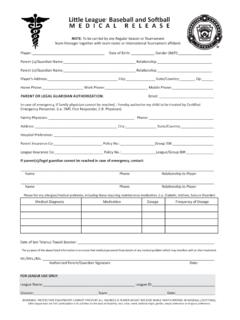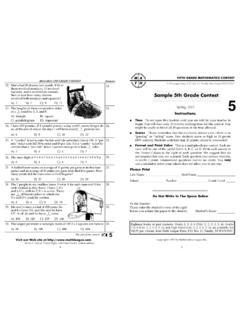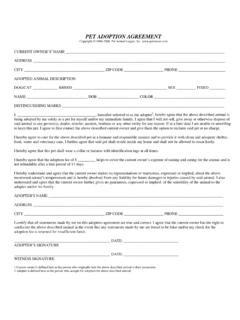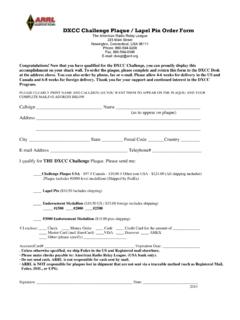Transcription of Raccoons -- Facts and Fancies - The Wildlife Rescue …
1 This information is reprinted from Rescue Report, the newsletter of the Wildlife Rescue league . If you have a concern about Wildlife in your back yard, contact the Wildlife Hotline at (703) 440-0800. Raccoons -- Facts and Fancies By Erika Yery, Licensed Wildlife Rehabilitator The raccoon (Procyon lotor) belongs to the carnivores grouping, a group that is composed of mammals which are primarily meat eaters, although many of them also eat berries, fruit, vegetables, eggs, acorns, beech and hickory nuts, grains, grasses, and bark, if nothing else is available.
2 All carnivores have five toes and large canine teeth. The raccoon is omnivorous and the ratio of plant to animal food varies by season and what is available. Raccoons are in the Procyonidae (procyon, meaning to wash) family which also includes the ringtail cat and coati, and probably the red panda. There are seven species of Raccoons in North America and 25 subspecies. Their weight varies from 12 to 35 pounds. Females are usually smaller than males. Their color is grayish-brown, and the tail has 5 to 7 complete dark rings, alternating with broader brown or gray rings.
3 The tip of the tail is always dark. Albinistic (white) and Melanistic (black) individuals are not uncommon. Raccoons have a highly developed sense of touch considered to be superior to other non-primate mammals. They can easily unlock doors and get into trash cans and other mischief. They have a keen sense of hearing and visual acuity consistent with their nocturnal habits. Raccoons are excellent climbers and are one of the few mammals that can descend vertical tree trunks headfirst. They are also strong swimmers and can easily cross rivers and lakes, but only venture into deep water as an escape route from trouble.
4 It is commonly believed that Raccoons wash their food. Evidence indicates that only those in captivity wash their food and that the washing is a fixed-motor pattern used in searching for aquatic prey in the wild. The name raccoon is derived from the Algonquin Indians and translates to he scratches with his hands . Raccoons are mostly nocturnal. Another myth about them says if they are seen out in the daytime, they must be rabid. It is quite common, especially in urban areas, for a healthy animal to venture out during the day if it is hungry or its den has been destroyed.
5 Frequently, mother Raccoons that are nursing kits will be forced to search for food night and day. If an animal is behaving normally in the daytime, it is probably not rabid and should be left alone. Raccoons are not territorial. Preferred terrain is forested, with ponds, lakes, marshes or streams. Raccoons are not found in terrain that lacks evergreen forests and water. When you release Raccoons , it is imperative to find a place where there is plenty of water, no hunting, and people willing to feed the Raccoons until they can find their own food.
6 Raccoons usually den in hollow trees, rock crevices, and ground dens. In late fall and early winter, their fur will thicken into a heavy winter coat and they will eat as much as they can find as during harsh weather. In winter, Raccoons will spend weeks in their dens without eating. Contrary to belief, Raccoons do not hibernate. Adult Raccoons breed between January and June, depending on environment and environmental conditions. The first breeding cycle is at about ten months of age. While males are physically able to breed in the first year, they usually do not because of competition with older males.
7 If the female does not become pregnant during the first estrus, she can come into estrus again four months later. This is where the late babies come in. Most babies are born in April and May; the gestation period is about 63 days. Male Raccoons have no role during gestation or cub-rearing. Litters are anywhere from one to seven; four is the usual size. Cubs are born very lightly furred, with a faint mask. Pigmented tail rings will either be present or will appear at about one week of age. Ears are pressed tightly to the head, and the eyes are closed.
8 The head seems large in comparison to the rest of the body. They typically weigh three to five ounces. When hungry, cold, or not in contact with another warm body, the cubs will start chattering, whine or twitter like birds. They can crawl in a spider-like fashion with all four legs in extension, but cannot climb or stand and support their full weight. The eyes open at about 21 days, the ears shortly thereafter. They will be very vocal at this age. They will churr, growl, hiss, and give an alarm snort. When five to six weeks old, most can walk, run, and climb very well.
9 Seven-week-old cubs will engage in active (and sometimes rough) fighting characterized by growling, squealing, biting, wrestling, and imitating adult defense postures. After about eight to nine weeks of age they begin eating solid foods in the wild and begin traveling with their mother. When four months old, they will be completely weaned. Raccoon mothers with cubs enjoy a privileged position in the raccoon hierarchy. Other Raccoons will defer to a female with cubs in feeding situations. This privileged status lasts as long as the cubs remain with the mother.
10 In northern areas (this applies to Virginia), cubs will stay with the mother close to a year until she is ready to breed again. In southern areas, cubs may go off on their own in the fall, but after dispersal will often reunite as a family from time to time in denning and feeding situations. Raccoons can live up to 16 years in the wild but most die before reaching five years. Studies show that the greatest mortality occurs during the second year of life. Principal causes of mortality are activities of man mainly hunting, trapping, automobiles, and dogs.










